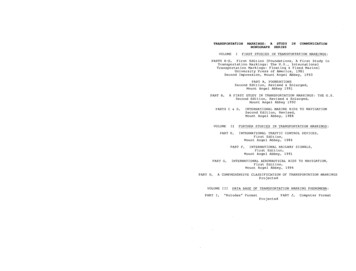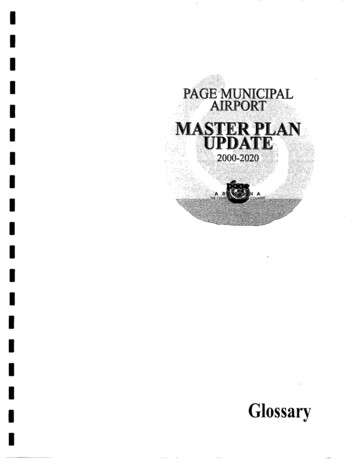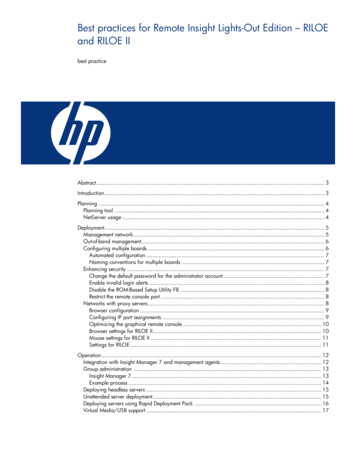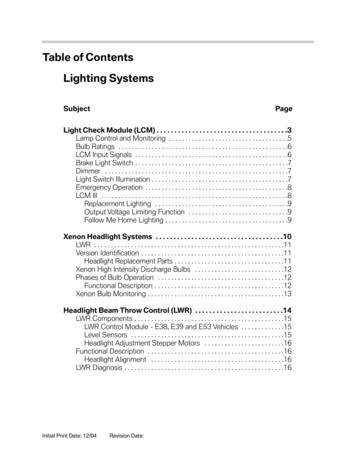
Transcription
HP Integrated Lights-Out Management ProcessorScripting and Command Line Resource Guidefor HP Integrated Lights-Out 2 version 2.00Part Number 382328-007June 2010 (Seventh Edition)
Copyright 2005, 2010 Hewlett-Packard Development Company, L.P.The information contained herein is subject to change without notice. The only warranties for HP products and services are set forth in theexpress warranty statements accompanying such products and services. Nothing herein should be construed as constituting an additionalwarranty. HP shall not be liable for technical or editorial errors or omissions contained herein.Confidential computer software. Valid license from HP required for possession, use or copying. Consistent with FAR 12.211 and 12.212,Commercial Computer Software, Computer Software Documentation, and Technical Data for Commercial Items are licensed to the U.S.Government under vendor’s standard commercial license.Microsoft, Windows, Windows Server, Windows Vista, Windows NT, and Windows XP are U.S. registered trademarks of MicrosoftCorporation. AMD is a trademark of Advanced Micro Devices, Inc. Intel is a trademark of Intel Corporation in the U.S. and other countries. Javais a U.S. trademark of Sun Microsystems, Inc.Intended audienceThis document is for the person who installs, administers, and troubleshoots servers and storage systems.HP assumes you are qualified in the servicing of computer equipment and trained in recognizing hazardsin products with hazardous energy levels.
ContentsIntroduction . 7Guide overview . 7New in this version . 7HP ProLiant Essentials Rapid Deployment Pack Integration . 7Server management through IPMI version 2.0 compliant applications . 8WS-Management compatibility overview . 8Command line . 10Command line interface overview. 10Command line access . 10Using the command line . 10Escape commands . 12Base commands . 12Specific commands. 13User commands . 14HP SIM SSO settings . 15Network commands . 16iLO 2 settings . 19iLO 2 embedded health settings . 21SNMP settings. 22License commands . 23Directory commands . 23Virtual media commands . 24Start and reset commands. 27Firmware update . 28Eventlog commands . 29Blade commands . 30Boot commands. 31LED commands . 32System properties and targets . 32Other commands . 35Telnet . 36Telnet support . 36Using Telnet. 36Telnet simple command set . 36Telnet security . 37Supported key sequences . 37iLO 2 VT100 key map . 37VT100 codes for the F-keys . 40Linux codes for the F-keys . 40Secure Shell . 41SSH overview . 41SSH features supported by iLO 2. 41Using Secure Shell . 42SSH key authorization . 42
Tool definition files. 43Mxagentconfig . 43Importing SSH keys from PuTTY . 43Importing SSH keys generated using ssh-keygen . 45Group administration and iLO 2 scripting . 46Lights-Out Configuration Utility . 46Unauthenticated XML query . 46Query definition in HP SIM . 47Application Launch using HP SIM . 47Batch processing using the Lights-Out Configuration Utility . 48Lights-Out Configuration Utility parameters . 49Perl scripting . 51Using Perl with the XML scripting interface . 51XML enhancements . 51Opening an SSL connection . 52Sending the XML header and script body . 53Virtual Media scripting . 55Scripting Web server requirements . 55Using virtual media scripting . 55Using Virtual Media on Linux servers through an SSH connection . 56Virtual media image files . 57CGI helper application . 57Setting up IIS for scripted virtual media . 58HPONCFG online configuration utility . 61HPONCFG . 61HPONCFG supported operating systems . 61HPONCFG requirements . 61Installing HPONCFG . 62Windows server installation . 62Linux server installation. 62HPONCFG utility . 62HPONCFG command line parameters. 63Obtaining the basic configuration. 64Obtaining a specific configuration . 65Setting a configuration . 66Using variable substitution . 67Capturing and restoring a configuration . 67Using RIBCL . 69Overview of the RIBCL . 69XML header . 69Data types . 70Response definitions . 70RIBCL . 71RIBCL parameters . 71RIBCL runtime errors . 71LOGIN . 71LOGIN parameters . 71LOGIN runtime errors . 71USER INFO . 72ADD USER . 72
DELETE USER. 74DELETE CURRENT USER . 75GET USER . 75MOD USER . 76GET ALL USERS . 78GET ALL USER INFO . 79RIB INFO . 80RESET RIB . 81GET EVENT LOG . 82CLEAR EVENTLOG. 83COMPUTER LOCK CONFIG . 84GET NETWORK SETTINGS . 85MOD NETWORK SETTINGS . 87GET GLOBAL SETTINGS . 91MOD GLOBAL SETTINGS . 93GET SNMP IM SETTINGS . 97MOD SNMP IM SETTINGS . 98UPDATE RIB FIRMWARE . 99GET FW VERSION . 101HOTKEY CONFIG . 101LICENSE. 103INSERT VIRTUAL MEDIA . 104EJECT VIRTUAL MEDIA . 105GET VM STATUS . 106SET VM STATUS . 107CERTIFICATE SIGNING REQUEST . 108IMPORT CERTIFICATE . 109GET TWOFACTOR SETTINGS . 109MOD TWOFACTOR SETTINGS . 110DIR INFO . 113GET DIR CONFIG . 113IMPORT SSH KEY . 115MOD DIR CONFIG . 116RACK INFO . 118GET RACK SETTINGS . 119GET DIAGPORT SETTINGS . 119MOD DIAGPORT SETTINGS . 120GET ENCLOSURE IP SETTINGS . 121MOD ENCLOSURE IP SETTINGS . 122GET TOPOLOGY . 123MOD BLADE RACK . 124SERVER INFO . 125GET SERVER NAME . 126SERVER NAME . 127GET EMBEDDED HEALTH . 127GET POWER READINGS . 130GET POWER CAP . 130SET POWER CAP . 131GET HOST POWER SAVER STATUS . 132SET HOST POWER SAVER. 132GET HOST POWER REG INFO . 133GET HOST POWER STATUS . 135SET HOST POWER . 135
GET HOST PWR MICRO VER . 136GET PWREG CAPABILITIES. 137RESET SERVER . 139PRESS PWR BTN . 139HOLD PWR BTN . 140COLD BOOT SERVER . 140WARM BOOT SERVER . 141SERVER AUTO PWR . 142GET SERVER AUTO PWR . 142GET UID STATUS . 143UID CONTROL . 144GET VPB CABLE STATUS (RILOE II only) . 144SSO INFO . 145GET SSO SETTINGS . 145MOD SSO SETTINGS . 146SSO SERVER . 148DELETE SERVER . 150HPQLOMGC command language . 152Using HPQLOMGC . 152ILO CONFIG . 152iLO 2 ports. 154Enabling the iLO 2 Shared Network Port feature through XML scripting . 154Re-enabling the dedicated NIC management port . 154iLO 2 parameters . 156Status Summary parameters . 156User Administration parameters. 157Global Settings parameters. 158Network parameters . 164Network DHCP/DNS parameters . 165SNMP/Insight Manager settings parameters . 166Directory settings parameters . 167BL p-Class parameters . 169iLO Advanced Pack License Key . 170Technical support . 171HP contact information . 171Before you contact HP. 171Acronyms and abbreviations . 172Index . 178
IntroductionGuide overviewHP iLO 2 provides multiple ways to configure, update, and operate HP ProLiant servers remotely. The HPIntegrated Lights-Out User Guide and the HP Integrated Lights-Out 2 User Guide describe each featureand explain how to use these features with the browser-based interface and RBSU.The HP Integrated Lights-Out Management Processor Scripting and Command Line Resource Guidedescribes the syntax and tools available to use iLO 2 through a command line or scripted interface.Sample XML scripts downloaded from the HP website contain commands for all iLO, iLO 2, and RILOE IIfirmware. Unless otherwise specified, examples in this guide are specifically for iLO 2 firmware version1.10 and later. Before using the XML sample scripts downloaded from the HP ghts-out/us/index.html), read the firmware supportinformation in each sample script to tailor the script for the intended firmware and version.New in this versionThis guide reflects changes in the iLO 2 firmware. This guide covers iLO 2 version 2.00. This version ofthe guide includes updates for the following:Updates: "Directory commands (on page 23)"HP ProLiant Essentials Rapid Deployment PackIntegrationHP ProLiant Essentials Rapid Deployment Pack integrates with iLO 2 to allow the management of remoteservers and the performance of remote console operations regardless of the state of the operating systemor hardware.The Deployment Server provides the ability to use the power management features of iLO 2 to power on,power off, or cycle power on the target server. Each time a server connects to the Deployment Server, theDeployment Server polls the target server to see if a LOM management device is installed. If installed, theserver gathers information including the DNS name, IP address, and first user name. Security ismaintained by requiring the user to enter the correct password for that user name.For more information about the ProLiant Essentials Rapid Deployment Pack, refer to the documentation thatships on the ProLiant Essentials Rapid Deployment Pack CD or the HP n7
Server management through IPMI version 2.0compliant applicationsServer management through the IPMI is a standardized method for controlling and monitoring the server.iLO 2 provides server management based on the IPMI version 2.0 specification.The IPMI specification de
Server management through the IPMI is a standardized method for controlling and monitoring the server. iLO 2 provides server management based on the IPMI version 2.0 specification. The IPMI specification defines a standar dized interface for platform management. The IPMI specification defines the following types of platform management:











